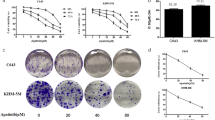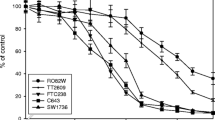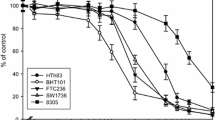Abstract
Current alternative therapies for refractory thyroid cancer such as kinase inhibitors have limitations including incomplete response and toxicity. Although tumour necrosis factor-related apoptosis-inducing ligand (TRAIL) can induce cancer cell-specific apoptosis, various degrees of TRAIL resistance have been reported for different types of thyroid cancer cells. Here, we investigated if modulation of autophagy could improve sensitivity to TRAIL in papillary and anaplastic thyroid cancer cells. Human papillary thyroid cancer cells (TPC-1 cells) and human anaplastic thyroid cancer cells (FRO cells) were treated with TRAIL after transfection with ATG7 siRNA or control siRNA. Levels of autophagy and apoptosis were confirmed by Western blot of ATG7, LC3, caspase-3 and poly (ADP-ribose) polymerase. Viability index was determined by dimethyl-thiazole-diphenyltetrazolium bromide assay. Fraction of apoptotic cells was determined by flow cytometry. In TPC-1 cells, treatment with TRAIL increased the levels of autophagy. A low concentration (20 ng/ml) of TRAIL resulted in significantly decreased viability index and increased apoptosis. However, inhibition of autophagy with ATG7 siRNA desensitised the cells to TRAIL-induced apoptosis. In FRO cells, TRAIL did not increase the levels of autophagy. In contrast to TPC-1 cells, inhibition of autophagy with ATG7 siRNA sensitised FRO cells to TRAIL-induced apoptosis. Autophagy might contribute to the known sensitivity of papillary thyroid cancer cells to TRAIL-induced apoptosis. Inhibition of autophagy in anaplastic thyroid cancer cells could sensitise these cells to TRAIL-induced apoptosis.






Similar content being viewed by others
References
C. Conticello, L. Adamo, R. Giuffrida, L. Vicari, A. Zeuner, A. Eramo, G. Anastasi, L. Memeo, D. Giuffrida, G. Iannolo et al., Proteasome inhibitors synergize with tumor necrosis factor-related apoptosis-induced ligand to induce anaplastic thyroid carcinoma cell death. J. Clin. Endocrinol. Metab. 92, 1938–1942 (2007)
J.Y. Guo, H.Y. Chen, R. Mathew, J. Fan, A.M. Strohecker, G. Karsli-Uzunbas, J.J. Kamphorst, G. Chen, J.M. Lemons, V. Karantza et al., Activated Ras requires autophagy to maintain oxidative metabolism and tumorigenesis. Genes Dev. 25, 460–470 (2011)
W. Hou, J. Han, C. Lu, L.A. Goldstein, H. Rabinowich, Autophagic degradation of active caspase-8: a crosstalk mechanism between autophagy and apoptosis. Autophagy 6, 891–900 (2010)
R.W. Johnstone, A.J. Frew, M.J. Smyth, The TRAIL apoptotic pathway in cancer onset, progression and therapy. Nat. Rev. Cancer 8, 782–798 (2008)
V. Langaas, S. Shahzidi, J.I. Johnsen, B. Smedsrod, B. Sveinbjornsson, Interferon-gamma modulates TRAIL-mediated apoptosis in human colon carcinoma cells. Anticancer Res. 21, 3733–3738 (2001)
L.C. Li, S. Jayarama, T. Pilli, L. Qian, F. Pacini, B.S. Prabhakar, Down-modulation of expression, or dephosphorylation, of IG20/MADD in tumor necrosis factor-related apoptosis-inducing ligand-resistant thyroid cancer cells makes them susceptible to treatment with this ligand. Thyroid 23, 70–78 (2013)
C.I. Lin, E.E. Whang, D.B. Donner, J. Du, J. Lorch, F. He, X. Jiang, B.D. Price, F.D. Moore Jr., D.T. Ruan, Autophagy induction with RAD001 enhances chemosensitivity and radiosensitivity through Met inhibition in papillary thyroid cancer. Mol. Cancer Res. 8, 1217–1226 (2010)
J.S. Long, K.M. Ryan, New frontiers in promoting tumour cell death: targeting apoptosis, necroptosis and autophagy. Oncogene 31, 5045–5060 (2012)
N. Mitsiades, V. Poulaki, S. Tseleni-Balafouta, D.A. Koutras, I. Stamenkovic, Thyroid carcinoma cells are resistant to FAS-mediated apoptosis but sensitive to tumor necrosis factor-related apoptosis-inducing ligand. Cancer Res. 60, 4122–4129 (2000)
A. Munshi, T.J. McDonnell, R.E. Meyn, Chemotherapeutic agents enhance TRAIL-induced apoptosis in prostate cancer cells. Cancer Chemother. Pharmacol. 50, 46–52 (2002)
J.W. Park, M.G. Wong, M. Lobo, W.C. Hyun, Q.Y. Duh, O.H. Clark, Modulation of tumor necrosis factor-related apoptosis-inducing ligand-induced apoptosis by chemotherapy in thyroid cancer cell lines. Thyroid 13, 1103–1110 (2003)
K.J. Park, S.H. Lee, T.I. Kim, H.W. Lee, C.H. Lee, E.H. Kim, J.Y. Jang, K.S. Choi, M.H. Kwon, Y.S. Kim, A human scFv antibody against TRAIL receptor 2 induces autophagic cell death in both TRAIL-sensitive and TRAIL-resistant cancer cells. Cancer Res. 67, 7327–7334 (2007)
J.C. Soria, Z. Mark, P. Zatloukal, B. Szima, I. Albert, E. Juhasz, J.L. Pujol, J. Kozielski, N. Baker, D. Smethurst et al., Randomized phase II study of dulanermin in combination with paclitaxel, carboplatin, and bevacizumab in advanced non-small-cell lung cancer. J. Clin. Oncol. 29, 4442–4451 (2011)
M. Subramanian, T. Pilli, P. Bhattacharya, F. Pacini, Y.E. Nikiforov, P.V. Kanteti, B.S. Prabhakar, Knockdown of IG20 gene expression renders thyroid cancer cells susceptible to apoptosis. J. Clin. Endocrinol. Metab. 94, 1467–1471 (2009)
H. Walczak, R.E. Miller, K. Ariail, B. Gliniak, T.S. Griffith, M. Kubin, W. Chin, J. Jones, A. Woodward, T. Le et al., Tumoricidal activity of tumor necrosis factor-related apoptosis-inducing ligand in vivo. Nat. Med. 5, 157–163 (1999)
Z.X. Xu, J. Liang, V. Haridas, A. Gaikwad, F.P. Connolly, G.B. Mills, J.U. Gutterman, A plant triterpenoid, avicin D, induces autophagy by activation of AMP-activated protein kinase. Cell Death Differ. 14, 1948–1957 (2007)
L.Y. Xue, S.M. Chiu, N.L. Oleinick, Atg7 deficiency increases resistance of MCF-7 human breast cancer cells to photodynamic therapy. Autophagy 6, 248–255 (2010)
S. Yang, X. Wang, G. Contino, M. Liesa, E. Sahin, H. Ying, A. Bause, Y. Li, J.M. Stommel, G. Dell’antonio et al., Pancreatic cancers require autophagy for tumor growth. Genes Dev. 25, 717–729 (2011)
Acknowledgment
This study was supported by Research Grant Number CB-2011-03-02 of the Korean Foundation for Cancer Research, a Samsung Medical Center grant [#CRO112101] and a Samsung Biomedical Research Institute grant [#C-B0-233-3].
Conflict of interest
The authors declare that there is no conflict of interest that could be perceived as prejudicing the impartiality of the research reported.
Author information
Authors and Affiliations
Corresponding author
Additional information
Sang-Man Jin and Hye Won Jang have contributed equally to this work.
Rights and permissions
About this article
Cite this article
Jin, SM., Jang, H.W., Sohn, S.Y. et al. Role of autophagy in the resistance to tumour necrosis factor-related apoptosis-inducing ligand-induced apoptosis in papillary and anaplastic thyroid cancer cells. Endocrine 45, 256–262 (2014). https://doi.org/10.1007/s12020-013-9997-8
Received:
Accepted:
Published:
Issue Date:
DOI: https://doi.org/10.1007/s12020-013-9997-8




